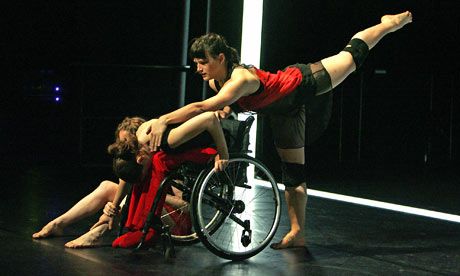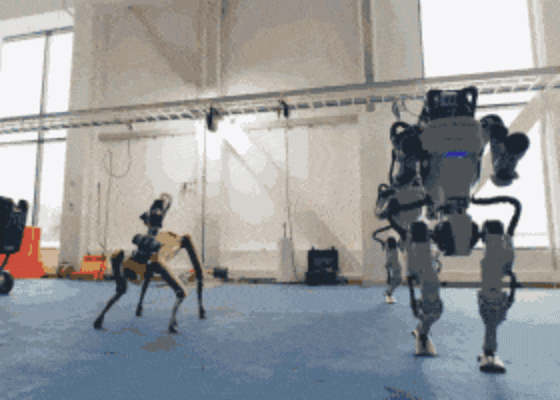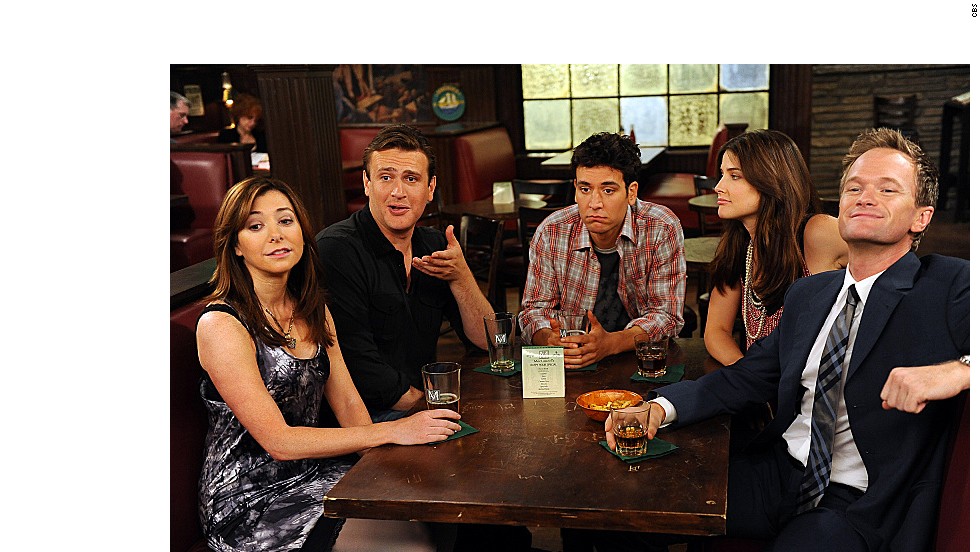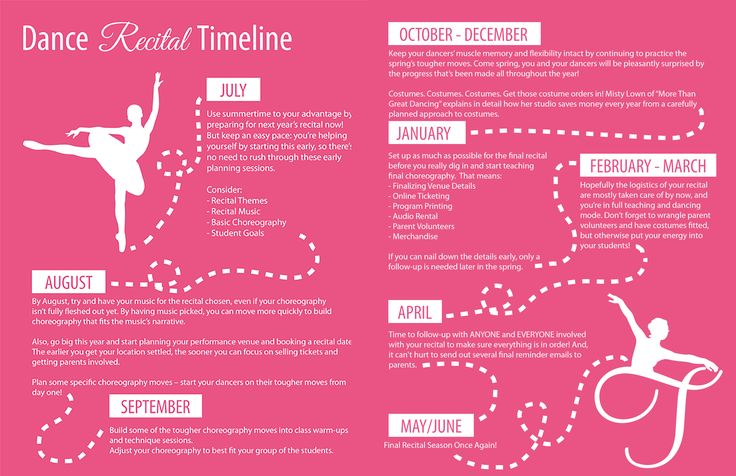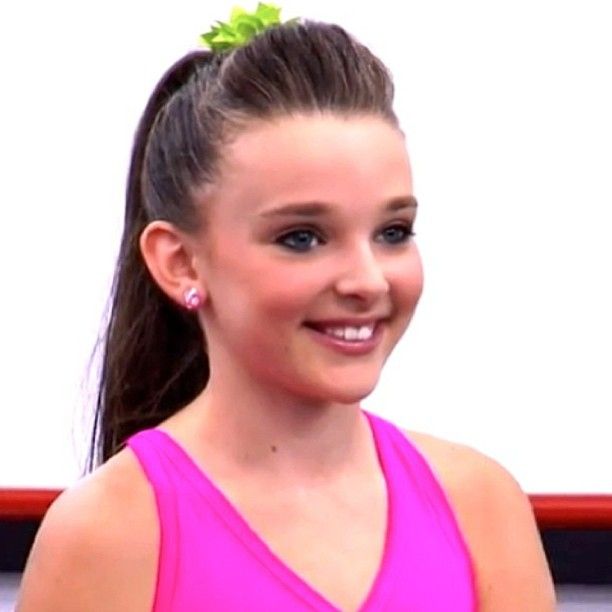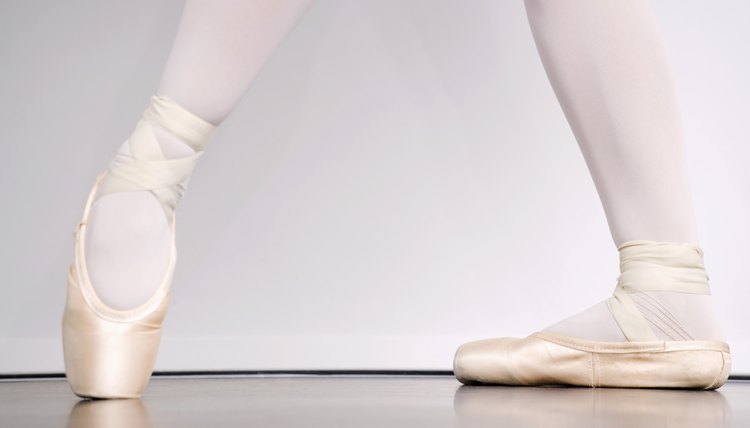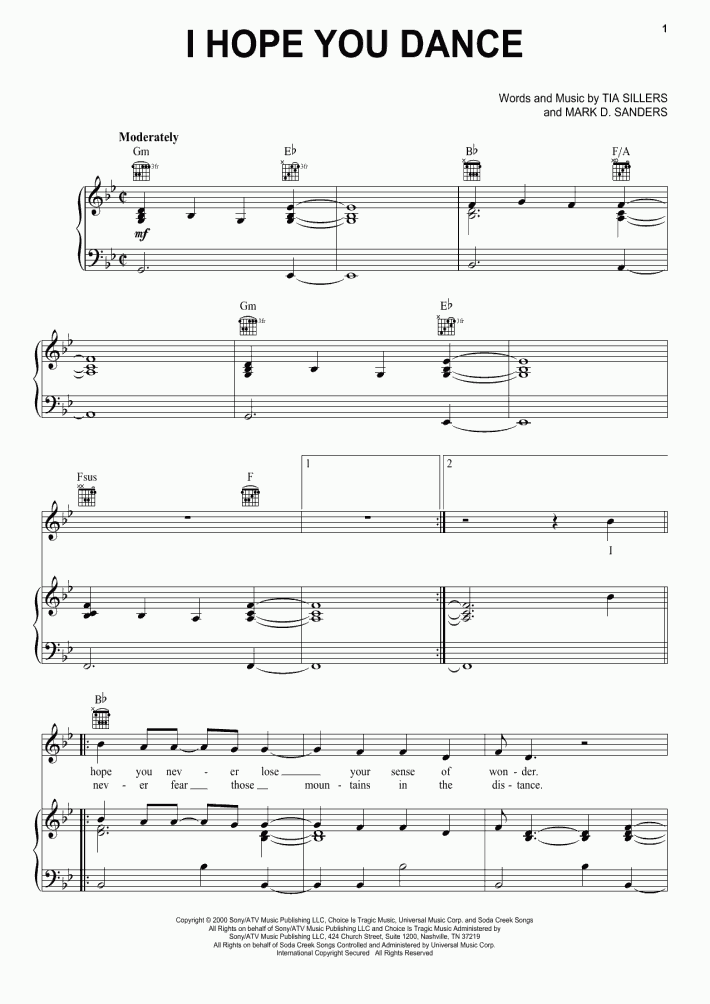How to dance in a wheelchair
6 Secrets About Ballroom Dancing In A Wheelchair, Revealed | by Eric Edling | Age of Awareness
The dance floor is one place I have never fallen. I’ve come close, but I have managed to win every fight that the ground picked with me. Take that, gravity. Dance has been an adventure ever since I started it six years ago. Ballroom dance is a challenge for anyone who does it, but people rarely see what it’s like for someone in a wheelchair. Here are six secrets from the world of wheelchair ballroom dancing.
- You Don’t Need Legs, You need Physics
“But how do you dance without…Y’know…-nervously gestures down to my legs-” I’m glad you asked. I could give a long speech about how the unbreakable human spirit finds always finds a way (gag), and that would be true…But let’s be logical for a minute. In dance, there are two things that everyone needs. The first thing that you need is something to move with. However, this ‘thing’ could be legs, arms, a jetpack, anything. Get creative with it. As long as you can move in different directions, having legs is irrelevant. Most dancers just happen to have working legs, because most people do.
Moving from there, let’s talk about the second thing you need. Take a look at the above picture. These two dancers are holding each other in a semi-flexible structure called a frame. When done correctly, each point of physical contact helps the two dancers work off of each other and move as a team; this is called physical connection. The slightest pressure against a palm, shift the shoulders, or twist of the waist helps the couple move together. Physical connection happens entirely through the upper body. I have both the means to move and to communicate with my partner in the same place.
2. Dancing With Me Is Easier Than You Think
“I would love to dance with you, I just don’t know how.”
Those words are my most significant barrier to dancing. My entire life is built around challenging misconceptions, but my approach to dance is unique.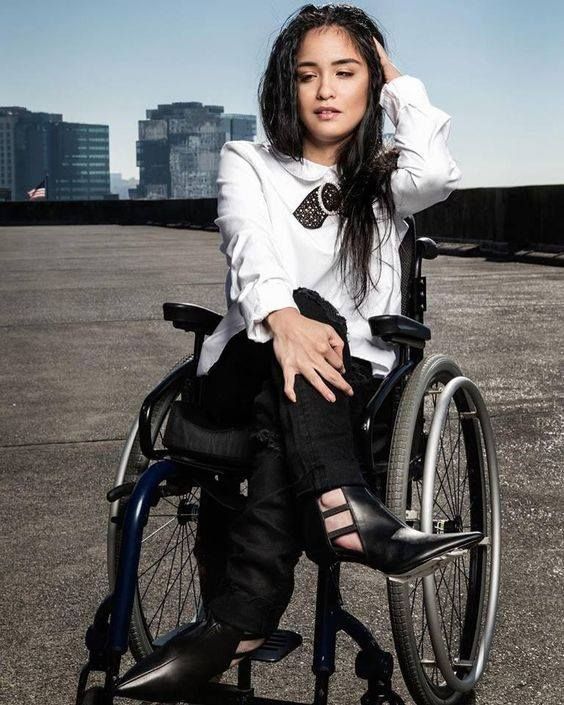 In most of my other hobbies, I only need one person to help me prove people wrong: me. Ballroom dance is different. As the saying goes, it takes two to tango. If I want to prove that I can dance as well as anyone, then I need a partner who is open to the experience. If I can’t find that partner, then I’m not dancing. If I’m not dancing, then nothing changes, and the cycle continues. Dancing with someone you like should be simple, so let’s set the record straight. If you know how to dance, you can dance with me. When you dance with me, almost nothing changes. The rhythm, lead, and follow are all the same. When you’re with me, there are only two things to keep in mind.
In most of my other hobbies, I only need one person to help me prove people wrong: me. Ballroom dance is different. As the saying goes, it takes two to tango. If I want to prove that I can dance as well as anyone, then I need a partner who is open to the experience. If I can’t find that partner, then I’m not dancing. If I’m not dancing, then nothing changes, and the cycle continues. Dancing with someone you like should be simple, so let’s set the record straight. If you know how to dance, you can dance with me. When you dance with me, almost nothing changes. The rhythm, lead, and follow are all the same. When you’re with me, there are only two things to keep in mind.
First, my center of gravity is lower. When your center of gravity is lower, your frame goes lower. Most dancers’ frames are at shoulder height, but when I take a lady’s hand, it stays at waist level. If my hand goes any higher, you won’t be able to feel my lead as easily. Second, if you want to get up close and personal, go for it. Dancing is supposed to be fun, sexy, and intimate. There is nothing less fun, sexy, or intimate than a partner that treats you like a twelve-year-old cousin. If a dance calls for you to get up in my grill, get up in my grill! If you’re not sure about how to, ask. Part of the fun is having someone who wants to play around and figure things out. Just don’t do anything that you wouldn’t do with an able-bodied partner. I’m sitting, but this isn’t a strip club and I didn’t ask for a lap dance. Follow my lead, and we’ll get as close to PG-13 as you‘re comfortable with. I promise.
Dancing is supposed to be fun, sexy, and intimate. There is nothing less fun, sexy, or intimate than a partner that treats you like a twelve-year-old cousin. If a dance calls for you to get up in my grill, get up in my grill! If you’re not sure about how to, ask. Part of the fun is having someone who wants to play around and figure things out. Just don’t do anything that you wouldn’t do with an able-bodied partner. I’m sitting, but this isn’t a strip club and I didn’t ask for a lap dance. Follow my lead, and we’ll get as close to PG-13 as you‘re comfortable with. I promise.
3. Being a Wheelchair User Makes Me a Better Dancer
So, I have all of the tools to be a dancer…But does being in a wheelchair affect the quality of my dancing? It does. Being in a wheelchair helps me be a better dancer. Think about this: when I dance, I have to connect with my partner, so my hands are busy the entire time. I rarely have a chance to push my chair myself, because I’m using my upper body to lead.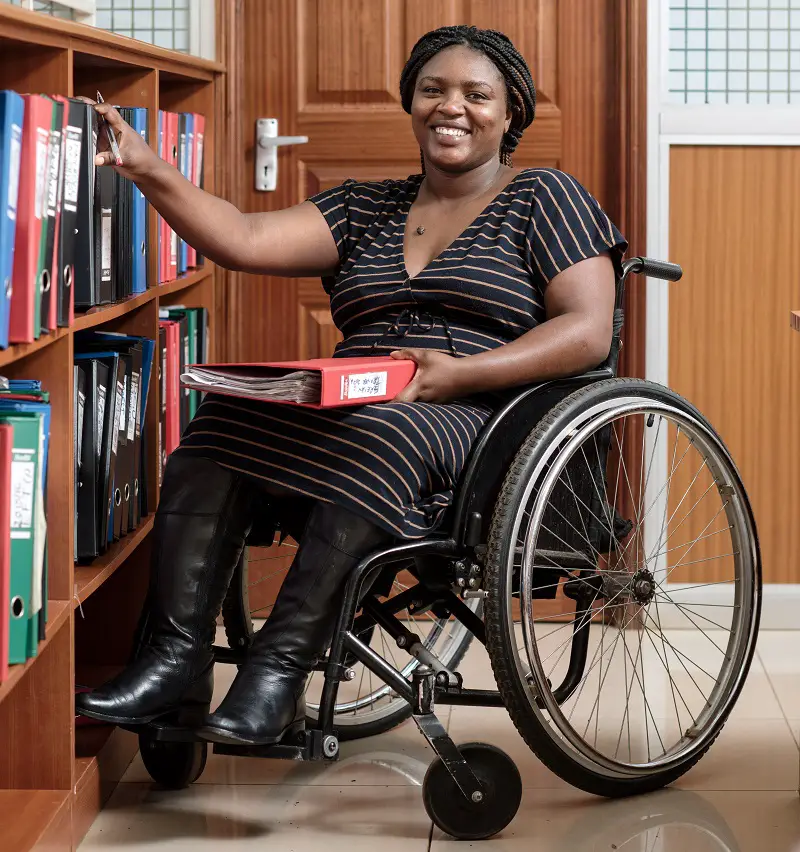 Because I can’t use the one thing that helps me move independently, I have to pay attention to every little movement. Did you shift half an inch to the left? I felt that. That small hip tilt? I felt that too. Your palm twitched, so I used the resulting connection to spin you twice. My connection is fine-tuned, down to the smallest interaction.
Because I can’t use the one thing that helps me move independently, I have to pay attention to every little movement. Did you shift half an inch to the left? I felt that. That small hip tilt? I felt that too. Your palm twitched, so I used the resulting connection to spin you twice. My connection is fine-tuned, down to the smallest interaction.
My hyper-sensitivity also helps me navigate the dance floor. Not all men are as careful on the floor as they should be. They step on their partners’ toes, awkwardly fumble around the floor, manhandle, and use their partner as a battering ram. Being treated like this is where I live most of the time, so I get it. Every day when I go out, I have to be aware of my space. A crowded room could make getting from one end to the other impossible. A party is a minefield of spilling drinks, tripping over legs, and bumping into awkward body parts. I face the possibility of manhandling daily, more than most men do. When I’m on the floor I have fun, but that part of my brain is firing on all cylinders.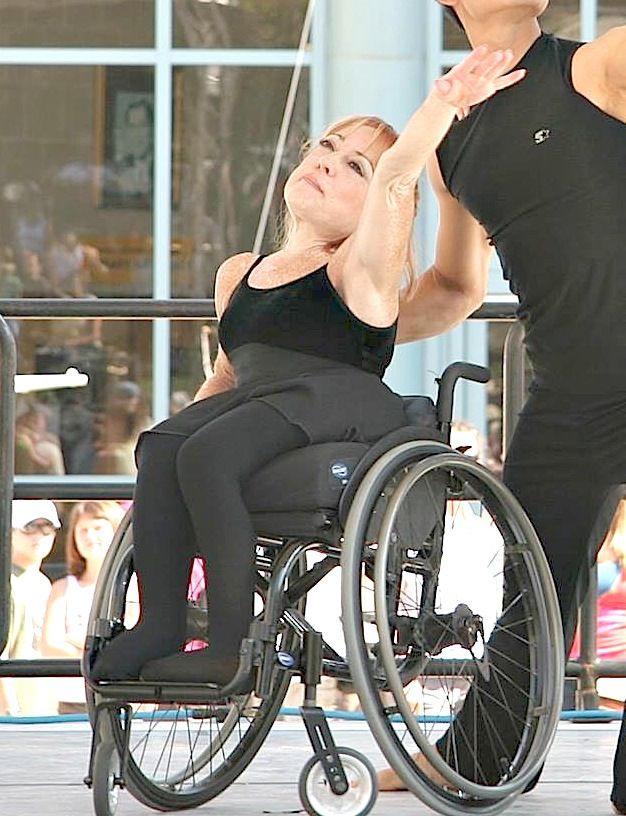
Being in a wheelchair also pushes me to put myself out there and take risks. I have a tendency to get involved in activities where everyone else is able-bodied. I’m used to people doubting me and having low expectations. Fortunately, I’m an adrenaline junkie with a wicked sense of humor. Few things make me happier than finding someone who doubts me, and saying “Oh, yeah? Watch this.” I have come to my partners with ideas that range from calculated risks to “Eric, that‘s insane, and the answer is no.” When I take a calculated risk, I rarely have the example of another dancer to follow. The world of amateur wheelchair ballroom dance is relatively small, and information is not as accessible as it should be. In moments where I take calculated risks, I have to be more self-aware about my skills and have the courage to trust myself and my partner.
Here, my partner Lindsey is doing an arabesque on my footplate as I rotate, like figures in a music box. This picture is from my first routine, less than a year after I started dancing.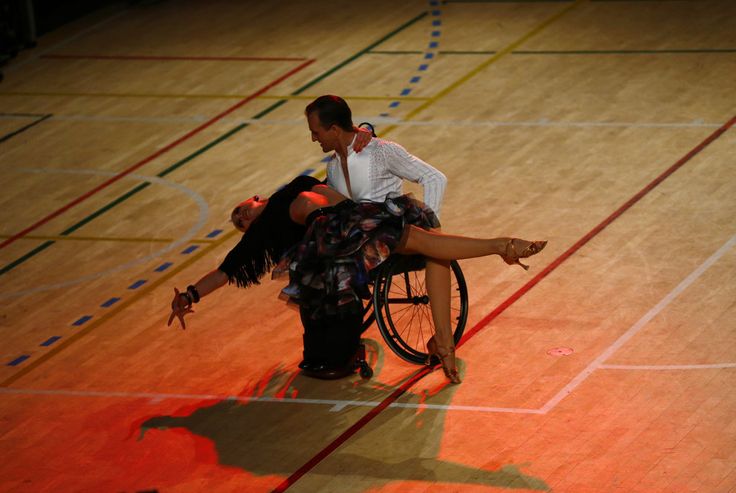 Was it easy? Nope. Was it safe?… Hehe. Mostly. Before we started, we had a long conversation about what the trick entailed and how we could make it safe. Then, we practiced for the next four months. She also threatened me within an inch of my life not to drop her, but she was kidding. Mostly.
Was it easy? Nope. Was it safe?… Hehe. Mostly. Before we started, we had a long conversation about what the trick entailed and how we could make it safe. Then, we practiced for the next four months. She also threatened me within an inch of my life not to drop her, but she was kidding. Mostly.
When Lindsey came up with the idea, I said yes immediately. Being in a wheelchair has taught me that when you’re up against the odds, and you find that people doubt you, you have to think outside the box. I had the skill, and I knew I could handle it, so I took the risk.
4. My Dancing Exposes Preconceived Notions.
Everyone at my studio is fantastic. They make up the vast majority of my friends, and I have never been happy to lose an instructor. When I first started, however, preconceived notions flew both ways. On the day I scheduled my first lesson, one of my wheels broke, and I have rarely been so relieved to cancel on someone. For me, dancing in a wheelchair was like going behind enemy lines.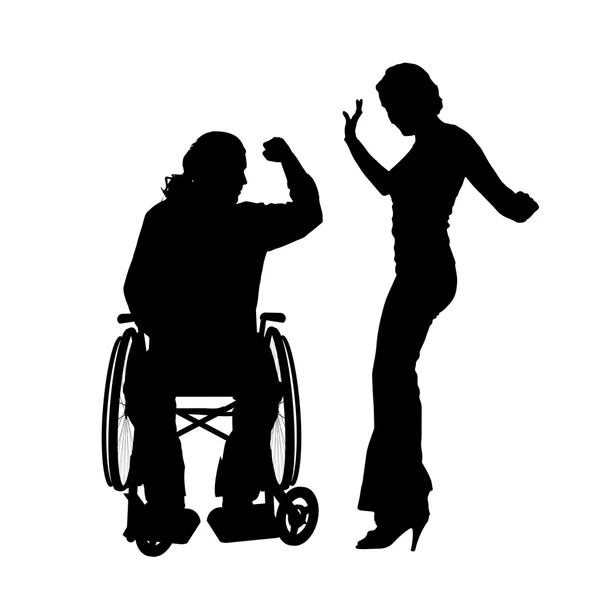 In my mind, no one there was going to understand me, and they weren’t there to try. I knew that most of the people there were career athletes and people who were a good thirty or forty years older than me. in my experience, views about disability from people in those groups didn’t inspire confidence. Those views can be hurtful, but are almost never caused by hate.
In my mind, no one there was going to understand me, and they weren’t there to try. I knew that most of the people there were career athletes and people who were a good thirty or forty years older than me. in my experience, views about disability from people in those groups didn’t inspire confidence. Those views can be hurtful, but are almost never caused by hate.
A dance instructor’s body is their livelihood. When you’re in that position, it’s easy to equate physical disability with your life being over. If you’re injured, you have to rework everything in your life and find something else to do. Many of the younger students feel similarly, since they’re typically career dancers who will become instructors. If I were in that position, disability would worry me too. Then, consider the students who are way out of my age range: they may have never experienced disability outside of a nursing home or a hospital. Many students and teachers from every level look for the tragedy in my life, and are surprised to find none there.
5. My Biggest Struggles Are Invisible
Dancing in a wheelchair comes with plenty of external challenges. I have had to push my physical limits hard to get where I am, but my physical limits have never brought me close to quitting. In fact, the struggles you can’t see are usually far worse. I am ultra-competitive. I push myself to be the best I can be, and I want to win everything. I’m also acutely aware that there are people who don’t take me as a “serious competitor.”; people who look at what I do and think, “Isn’t that sweet? They’re ‘letting’ him perform.” Imagine being on the floor, and having those thoughts running through your head. Imagine the lung-squeezing, head-spinning anxiety you might get from that much pressure. Then, consider the following:
I have anxiety anyway.
For me, anxiety is also a biological condition. Many people in my family have it, and although I’ve learned to manage it, I’ll always have it in some form. For a long time, my anxiety was debilitating.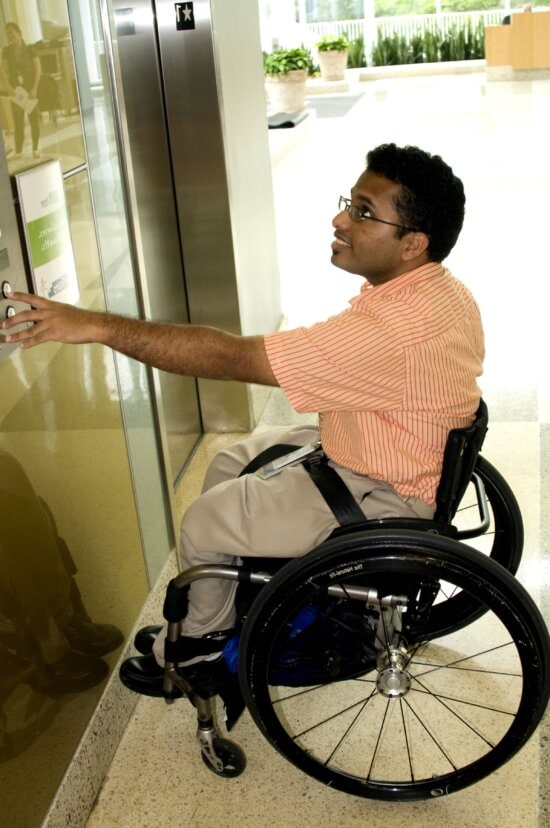 On the dance floor, I looked plain unhappy. At competitions I would tremble all day, which made it exhausting to smile or be expressive. Crowded floors drove my fight or flight reflexes through the roof, so making eye contact with my partner was out of the question. I loved dance, but my anxiety made it so hard to express that.
On the dance floor, I looked plain unhappy. At competitions I would tremble all day, which made it exhausting to smile or be expressive. Crowded floors drove my fight or flight reflexes through the roof, so making eye contact with my partner was out of the question. I loved dance, but my anxiety made it so hard to express that.
Four years ago, everything got bad enough that I nearly quit. Everyone has a dance that didn’t go as well as they thought. For me, that dance was my third rhythm competition. I made one or two small missteps, but overall I felt like I had done better than I ever had before. This was it. I had worked so hard, and everything went exactly the way it was supposed to. Surely, I was going to place. This was my moment…or not. I got eighth place out of eight, and from there, the pressure cooker of my mind exploded. All of the anxious thoughts I had been carrying all day came pouring out. Clearly, your best isn’t good enough. You failed. You don’t belong here. You’re not a “serious competitor,” and everyone knows it.
You’re not a “serious competitor,” and everyone knows it.
As I shook hands and congratulated everyone, my lungs began to close. Then, my head started to spin. By the time I reached my car, I was trembling, hyperventilating, and my heart was beating hard against my chest. I couldn’t do it anymore. I had won awards for multiple routines, but I still wasn’t “good enough” at competitions. My anxiety had improved immensely, but moments like these were still happening. Dance just wasn’t meant to be. Something had to give- I had to stop. I took out my phone, pulled up my studio’s phone number, and my finger hovered over the call button. No one was there, so I could leave a message, and no one would argue. I don’t know what stopped me, but I am so glad I didn’t make that call. It has been four years, and almost no one knows about my anxiety, much less about what happened that day. Everyone has bad days, but when you have a disability, people try to turn your bad days into tragedies. So, it’s hard let myself be human.
So, it’s hard let myself be human.
6. I Get To Be Subversive
Discussing my disability with people feels like opening Pandora’s box. One day, I could open the box and find empowerment, respect, and openness with the people in my life. The next day, I might open the box to find that my friends are not who I thought they were, or that the world hasn’t made as much progress as I thought. These conversations are just as scary for the person on the other end because they threaten to reveal layers of ignorance, fear, and prejudice, even if the person doesn’t mean to be hurtful. That’s terrifying. So, some people approach me in a way that looks and feels kind, but allows them to sidestep difficult conversations and stay in their comfort zone. The interactions we have might feel good, but they don’t confront any of the pressing issues that lead to camaraderie, respect, or a real connection.
On a day to day basis, most of the discrimination that I face goes unnoticed. I have never been spat on or threatened, and I have rarely been called slurs. Most day to day discrimination looks like what I described above; people who sidestep real emotions and avoid talking about real issues. Practical problems like accessibility are chalked up to me having a bad attitude and swept under the rug. Dance helps me open Pandora’s box because it doesn’t let anyone sidestep emotion. If I want to tell a personal story through dance, then I have to be honest. If my partner wants to help tell that story, then she has to be open to hearing things that are difficult to accept. If that doesn’t happen, then the art we create won’t be meaningful.
I have never been spat on or threatened, and I have rarely been called slurs. Most day to day discrimination looks like what I described above; people who sidestep real emotions and avoid talking about real issues. Practical problems like accessibility are chalked up to me having a bad attitude and swept under the rug. Dance helps me open Pandora’s box because it doesn’t let anyone sidestep emotion. If I want to tell a personal story through dance, then I have to be honest. If my partner wants to help tell that story, then she has to be open to hearing things that are difficult to accept. If that doesn’t happen, then the art we create won’t be meaningful.
Art has the power to break down walls that people might not know existed; it allows me to get under the audience’s skin in a way that they enjoy. Nevertheless, it is a powerful form of rebellion that should never be discounted. So, the next time you see me on the dance floor with a beautiful woman, remember: I don’t dance because it’s sexy.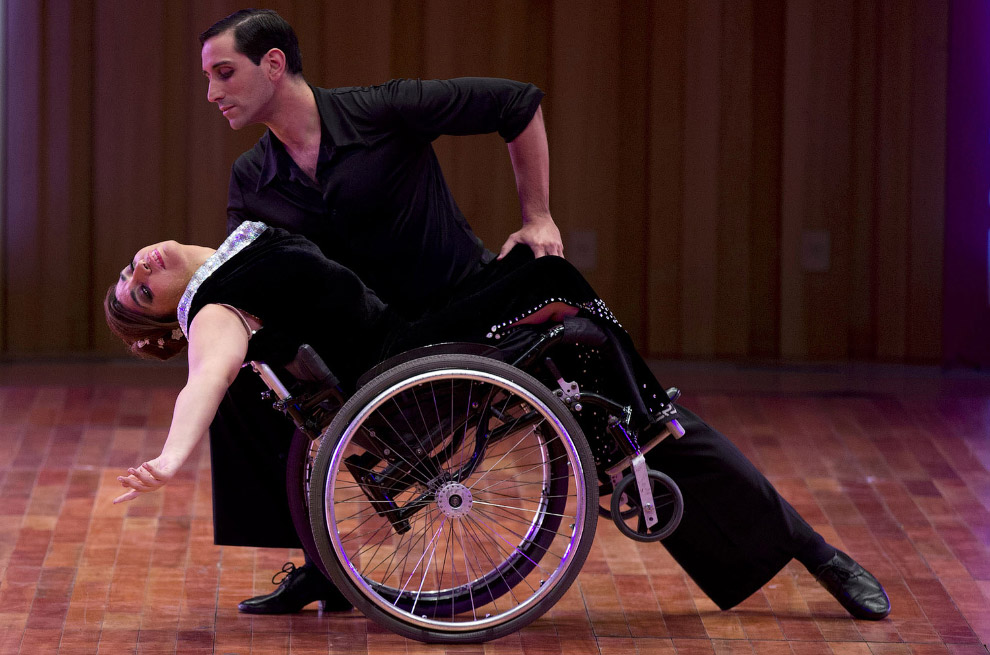 I dance because I’m a rebel.
I dance because I’m a rebel.
….and also because it’s sexy.
Wheelchair dancing, an activity anyone can enjoy
Being in a wheelchair and having reduced mobility doesn't mean you can't dance. If you want, there's nothing stopping you from blasting the music and busting your best moves! Wheelchair dancing can be a profession, a fundraising activity or rehab therapy. But all of its applications have something in common: they are beneficial and very fun.
Being in a wheelchair and having reduced mobility doesn't mean you can't dance.
As an artistic profession, we have to mention the most competitive wheelchair dances: those at world championships with professional dancers. These are partner dance competitions where at least one of the dancers is in a wheelchair. The activity has been regulated by the International Paralympic Committee since 1998 and is coordinated by the IPC Wheelchair Dance Sport Technical Committee, which incorporates the technical rules established by the World DanceSport Federation. At these championships, with overwhelming elegance, the best dancers face off in three categories: standard (waltz, tango, etc.), Latin (samba, rumba, paso doble, etc.) and freestyle (folk, hip hop, etc.).
At these championships, with overwhelming elegance, the best dancers face off in three categories: standard (waltz, tango, etc.), Latin (samba, rumba, paso doble, etc.) and freestyle (folk, hip hop, etc.).
A good example of wheelchair dancing as a fun fundraising tool is the Walk&Roll Foundation. Women with disabilities united by their passion for dance travel around California performing their choreographies. But the most important aspect is what's behind it all: these girls, through the foundation, motivate people with disabilities to pursue their dreams despite the difficulties. A spinal injury changed their lives but thanks to the Walk&Roll Foundation, they've kept on dancing. If they can, everyone else can too. And, of course, their performances are really cool!
To finish up, one of the most enriching and fun options is dance as rehab therapy and integration tool for wheelchair users.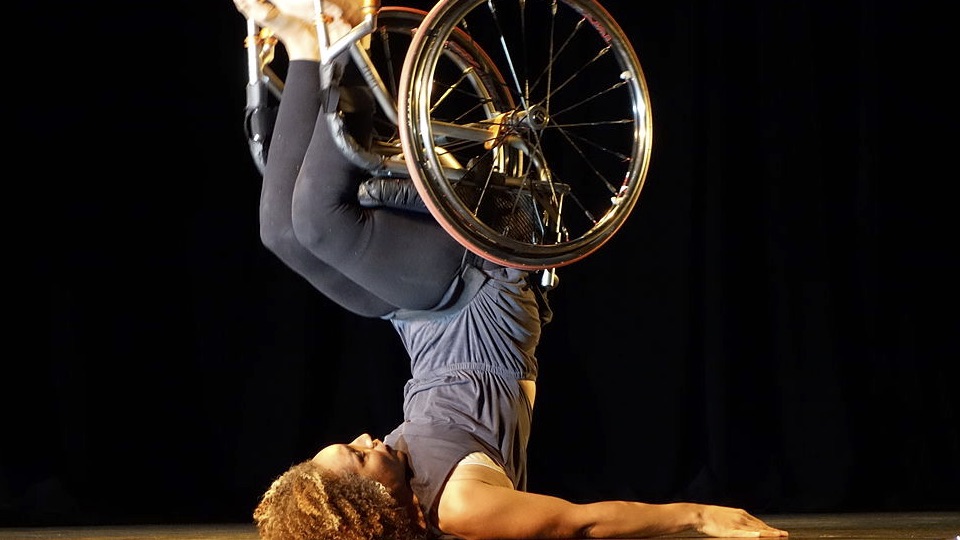 One example is the integrated dance association called Liant la Troca, from the city of Granollers. It is led by Jordi Cortés, dancer and choreographer, and organised by Patricia Carmona.
One example is the integrated dance association called Liant la Troca, from the city of Granollers. It is led by Jordi Cortés, dancer and choreographer, and organised by Patricia Carmona.
Patricia, who was left quadriplegic after an accident, found the satisfaction she used to get from rhythmic gymnastics in wheelchair dancing. Created in 2011, Liant la Troca is made up of people with "different artistic and motor abilities to convey to the audience concepts of ability, integration, accessibility and inclusion, making them forget concepts like disability, rejection, segregation, etc." Through art and movement, they delight us with their performances (their schedule is available online). In addition to her artistic side, Patricia fights tirelessly for the rights of people with physical disabilities, presides over the Aspaym Cataluña association and was a pioneer in using our handbikes as the second user of the BATEC QUAD ELECTRIC after its inventor Pau Bach.
«Liant la Troca is made up of people with 'different artistic and motor abilities to convey to the audience concepts of ability, integration, accessibility and inclusion'.»
Furthermore, if we hop over to Pamplona, we find the Esther Amorós dance school. Esther, a dance teacher, along with the Government of Navarra, launched a project to study the benefits of dancing on people with physical disabilities. The conclusion was that they are all positive: improving coordination, mobility, flexibility and social inclusion by fostering social relationships. At her dance school in Barañáin (Pamplona) you can have fun while getting all the benefits of dancing.
Wheelchair dancing has positive effects: improving coordination, mobility, flexibility and social inclusion by fostering social relationships.
Who's up for moving their wheels to the beat? ;-)
Dancing in wheelchairs: Anastasia Vasilenko - about how she learned to dance with cerebral palsy and now teaches others to dance
Anastasia Vasilenko, who was confined to a wheelchair from birth, found out at the age of twelve, when she met in a youth camp with her first coach and performed the waltz for the first time.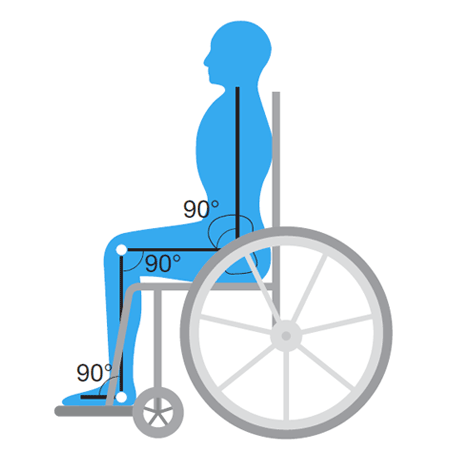 Now the girl has more than thirty awards of the Russian and world championships in ballroom dancing in wheelchairs and many students from seven to thirty-five years old. Anastasia told Knife about how she overcame her doubts and started dancing without being able to walk, and about how she helps other children with cerebral palsy find themselves in dancing.
Now the girl has more than thirty awards of the Russian and world championships in ballroom dancing in wheelchairs and many students from seven to thirty-five years old. Anastasia told Knife about how she overcame her doubts and started dancing without being able to walk, and about how she helps other children with cerebral palsy find themselves in dancing.
Illustrative photo: Students of the dance studio Happy Hearts ("Happy Hearts") at the Children's Center "Matveika" in Narva Andrey Naruson and Maria Vasilyeva (from the personal archive of Yulia Chizhikova)
Dancing or swimming? Nice dress!
The fact that I cannot walk is the result of a medical error. Almost immediately after birth, I was injected with some new drug, still little tested, and my mother was told: “Thank you for staying alive at all.” It was 1994 years old, then no one began to figure out why this happened.
I have a full-fledged family, I have a younger brother.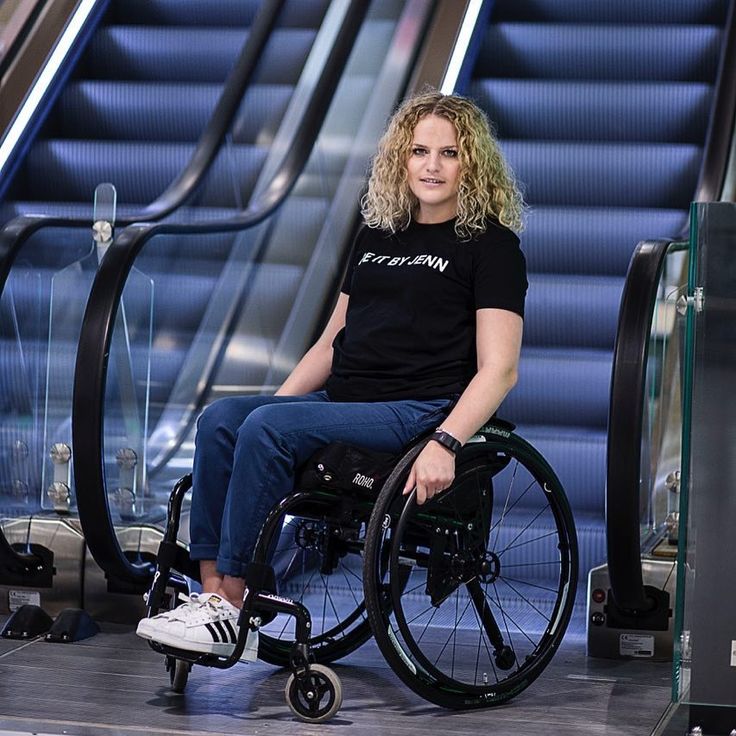 Since childhood, I have not felt like some kind of "not like that."
Since childhood, I have not felt like some kind of "not like that."
Yes, there were times when I was poked with a finger, but I made it a rule to just smile when faced with contempt or surprise.
Until the 5th grade, I lived in Moscow, went to a general education school with healthy peers and never felt that I was any different from them.
Then we moved to Zelenograd, where I lived for ten years. I had to switch to home schooling: my mother raised her younger brother and could not take me to classes. I was enrolled in the Icey Moscow distance learning school (Lyceum No. 1) - this is an institution for children who, for various reasons, cannot attend a regular school. There we were given computers, scanners, webcams. When my brother grew up a little, I had the opportunity to come to face-to-face classes.
When faced with the choice between dancing and swimming, I chose to wear beautiful dresses rather than a rubber cap. In addition, I really loved Disney cartoons, and they are all musical and dance. My favorite cartoon is The Lion King, it has amazing music.
My favorite cartoon is The Lion King, it has amazing music.
I was twelve years old when my brother and mother and I went to a youth health camp near Minsk for three weeks. There was a huge sports complex on its territory, and it became interesting to me what was there.
I went there and saw a girl in a wheelchair and a healthy young man on their feet dancing a waltz. I looked at them fascinated and thought, how do they do it?
There was lightness and grace in this dance, and I immediately remembered Disney cartoons. A girl in a wheelchair drove up to me and asked: “Do you want to try dancing too?” I immediately agreed. It was my first and best coach — Anna Gorchakova, multiple European and world champion in wheelchair dancing. She taught me the main skills - how to properly hold the body, fall from a wheelchair, control my hands and feel the music.
I really liked the waltz
The hardest part was figuring out how to sit in the dance wheelchair. It differs from the usual one - the wheels are 45 degrees beveled to promote fast rotation, it is small and it does not have a back, so you need to try to keep the body so as not to fall. Therefore, falling correctly was the most important skill.
It differs from the usual one - the wheels are 45 degrees beveled to promote fast rotation, it is small and it does not have a back, so you need to try to keep the body so as not to fall. Therefore, falling correctly was the most important skill.
Such strollers are created individually for each dancer and are more expensive than usual. But at our school we have spare wheelchairs for children who do not have the opportunity to purchase them.
I liked the waltz the most, and that's where we started.
When something did not work out for me, I stayed until late in the evening and practiced the movement.
Returning to Moscow, I decided to find a similar section and found the Philanthropist Charitable Foundation, where I met my second teacher. She turned out to be the opposite of my first coach. I was twelve years old, I looked at her with admiration, but she didn’t seem to even try to teach me something new, didn’t give me more than I already knew how to do, and I began to invent dances myself. I was reviewing Disney cartoons and looking in these melodies, in the cartoonish movements of the characters, for ideas for my own dances.
I was reviewing Disney cartoons and looking in these melodies, in the cartoonish movements of the characters, for ideas for my own dances.
I have had four partners in my entire sports career. With one of them, Alexander Molokanov, we now teach together at my school "Symphony of Dance". My last partner, with whom I danced until 2017 (then I left the sport), was healthy, on his feet.
There are three types of wheelchair ballroom dancing: solo, combined (when one of the partners is on their feet) and duets in wheelchairs.
I was eighteen years old and I was in my first year at the Moscow State Psychological and Sociological University when I was offered to teach at Philanthropist. When I saw that I would have to teach dance to people suffering from cerebral palsy in a complex form, I was shocked - in order to dance, you need a normally functioning head, arms and body. My knowledge of psychology helped me a lot - I found the key to each student, so now we have excellent interaction and they win championships.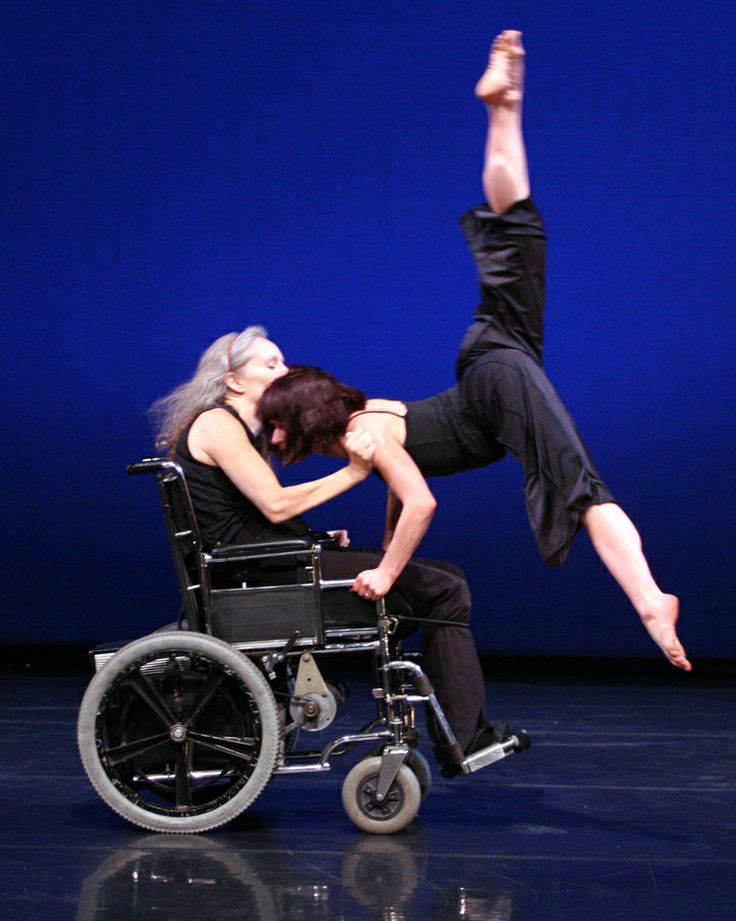
I attach great importance to the communication of students with each other
Among my students there are conditionally healthy, with a mild form of cerebral palsy, and with a very complex form of the disease. Mixed class. In my work, I first try to find out who they are, what they want and what they strive for. I attach great importance to the communication of students with each other. I am proud that each of them opened up in a new way - for me the most important thing is that any of my students be independent. Our golden rule is to expel parents from the class and train the guys in an adult way. It provides tremendous progress.
I am particularly happy when I see my students showing independence in their daily activities. Once, during a training session, I got a sore throat and coughed, then my student with a complex form of cerebral palsy drove up to her bag herself, pulled out lollipops, put them on her knees, brought them to me and said: “Please take it so that you stop coughing ".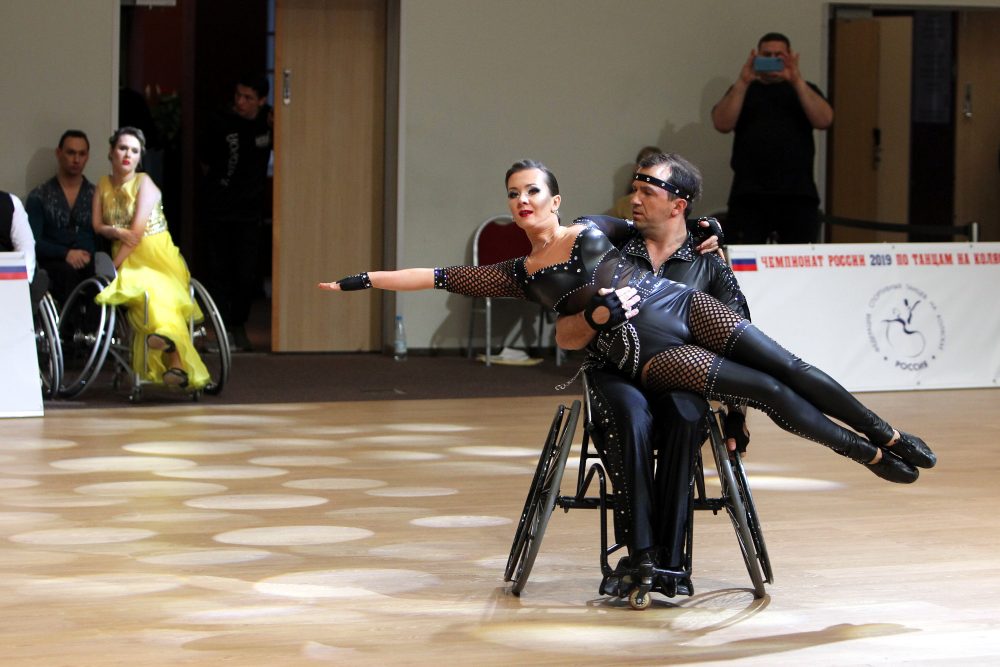 This was also an achievement - she did everything herself, no one helped her.
This was also an achievement - she did everything herself, no one helped her.
Some of the boys in my group were very reserved, they said that they would never succeed, that they were somehow not like that, and now they dance both tango and waltz. They have gained self-confidence, and they interact easily with their partners.
Dancing helps them change their attitude towards themselves . Limited possibilities turn out to be unlimited. If a person is used to thinking that he is disabled and that he will not succeed, it is difficult to convince him. But thanks to dancing, there is no need to convince anyone, people themselves begin to realize that they are capable of much. I was shocked when I heard a mother say to a child: "You are a disabled person." For me, this is wildness - what kind of socialization can we talk about with such an attitude? I want dancing to help these guys feel normal. After classes, many share their feelings with partners.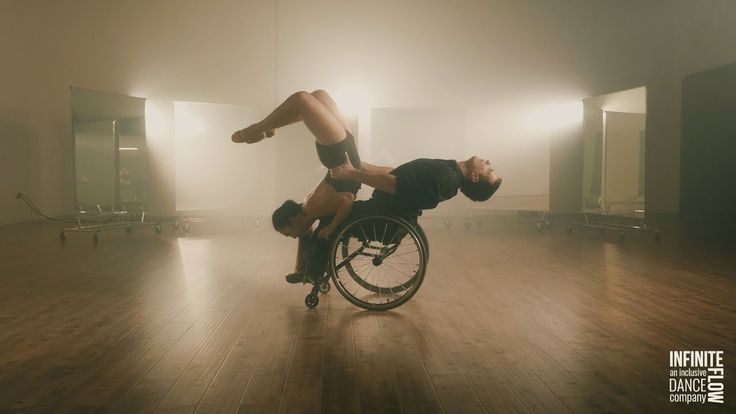 We have amazing communication.
We have amazing communication.
In addition, playing sports has a beneficial effect on the body. In my school, in addition to the actual choreography, the load also includes exercise equipment, a swimming pool. Every year we undergo a medical examination, and each athlete is selected a set of exercises that are suitable for him due to his state of health.
I spontaneously created the "Symphony of Dance" school. When we parted ways with my coach, I realized that I wanted to show, explain, train with someone myself. And together with my boss from the Meshchansky Social Service Center, we decided to announce my project "Symphony of Dance" at one of the regular Moscow forums, where deputies ask residents what they want in order to realize their wishes. They gave me my word. My second teacher was also present on this forum and deleted my presentation right before I left. I was upset because I didn’t understand where this jealousy came from, why competition is needed here? Then my young man reassured me, and I spoke without a presentation.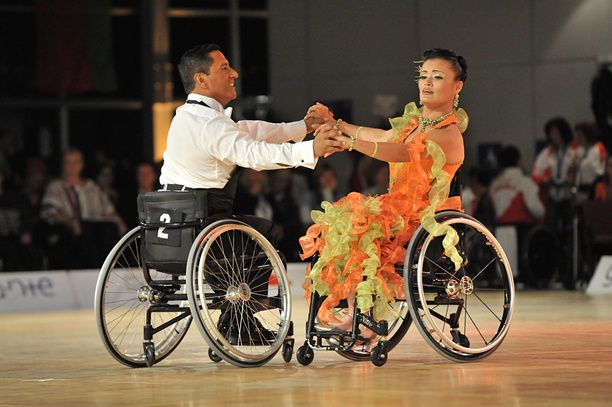 I was given a chance. So since 2016, in the hall of the Meshchansky CSO, I began to train children with cerebral palsy. Usually there are about twenty children in a group.
I was given a chance. So since 2016, in the hall of the Meshchansky CSO, I began to train children with cerebral palsy. Usually there are about twenty children in a group.
I take children from seven to thirty-five years old. Now I have ten conditionally healthy students. These are people who can walk and use a wheelchair without strain. There is a seventeen-year-old girl with Down syndrome, very talented. At present, there are no very young ones (although I once studied with a five-year-old girl), my youngest student is seventeen, and the oldest is thirty-five years old, and he is seriously ill with cerebral palsy.
All dance numbers, music and images I come up with myself.
Our first number is a waltz combined with a foxtrot. I combined these styles because children with complex forms of cerebral palsy cannot turn the stroller, they do everything slowly, but they accurately catch the rhythm of the music.
We had a number "Out of orbit" to the song of Yulianna Karaulova.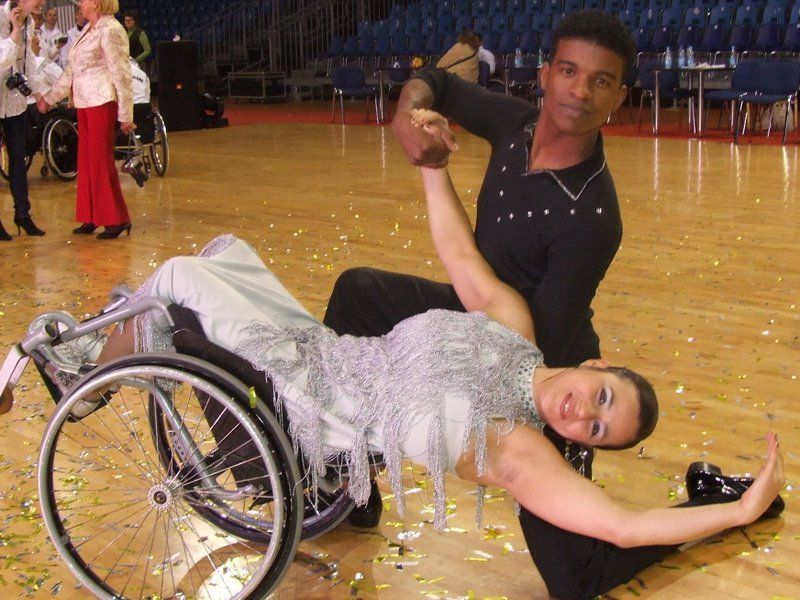 Children always smiled, tried to hit the tune, they felt like stars! We defined the genre as fantasy dance. Everyone knows something in their own way, and in general it turns out very beautifully.
Children always smiled, tried to hit the tune, they felt like stars! We defined the genre as fantasy dance. Everyone knows something in their own way, and in general it turns out very beautifully.
I hope that the open Moscow championship in wheelchair dancing will take place in the fall, and now my partner and I are preparing each student for it.
I consider it important that every athlete from Russia stand on the podium. To get there, you had to go through several stages. First, my partner and I won the open Moscow championship, where the coaches of the Russian national team review the pairs and, based on the results, invite them to the team. We were selected, and we went to the Continental Cup (now it is called the World Cup). We went to subsequent championships at the expense of the state.
Selection for the World Cup is held in St. Petersburg, where the Wheelchair Ballroom Dance Federation is located. The Russian Championship was also held there. Italy, Poland, and many other countries hosted the European Championships... But the most memorable performance I had was in Kamchatka, where we flew with my healthy partner. We were seen at some competition and invited to perform there as guest stars. It was phenomenal. I remember how, after an eight-hour flight, I saw incredible beauty - these mountains, this snow, I tried crabs, fish ... I was shocked. And the performance in China made a big impression on me.
Italy, Poland, and many other countries hosted the European Championships... But the most memorable performance I had was in Kamchatka, where we flew with my healthy partner. We were seen at some competition and invited to perform there as guest stars. It was phenomenal. I remember how, after an eight-hour flight, I saw incredible beauty - these mountains, this snow, I tried crabs, fish ... I was shocked. And the performance in China made a big impression on me.
There are a lot of championships in my biography. I have about thirty-five cups. If we talk about the most honorable ones, I am a three-time champion of Russia and a two-time world champion.
As a child, it didn't matter to me whether I won a prize or not, I was driven only by the desire to dance. I didn’t even pay attention to the first medals and cups - I was just glad that I was able to show other people how a wheelchair dance can become a work of art. My ex-husband also did not like my awards, apparently, and this was not the main thing for him.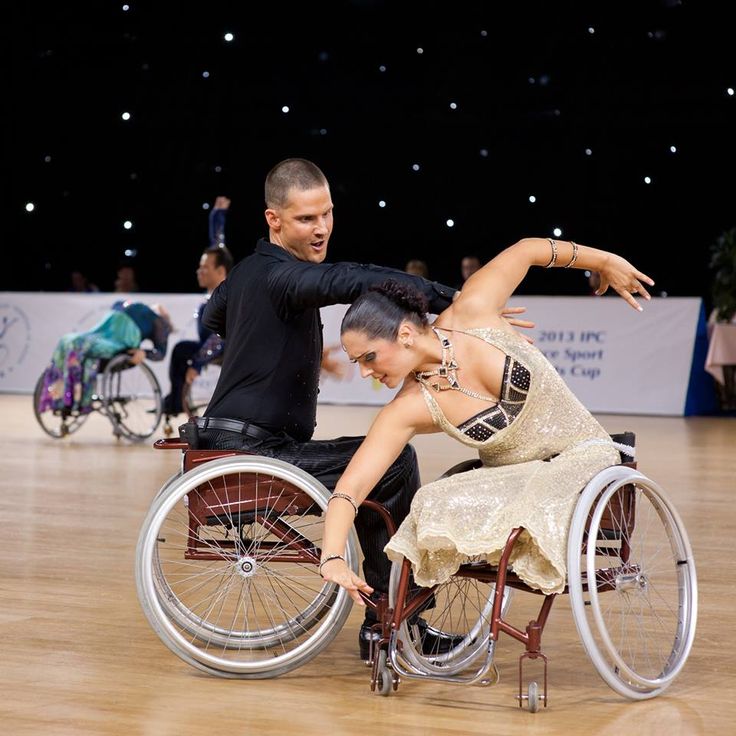 But now I consider it important that every athlete from Russia be on the podium (it doesn’t matter the first, second or third place), defending the honor of their country.
But now I consider it important that every athlete from Russia be on the podium (it doesn’t matter the first, second or third place), defending the honor of their country.
If I couldn't make it to the top three, I kept working to make sure I took the top spot next time.
Unfortunately, the situation with the removal of the Russian Paralympic team from international competitions due to a doping scandal has also affected us. We compete under the auspices of the Russian Paralympic Committee and have not traveled to international championships for several years.
In 2019, I watched the broadcast of the World Wheelchair Ballroom Dancing Championships, held in Sweden, and was somewhat disappointed - there was a lot of mechanical in the performance, and this is exactly what I struggle with in my work. My students emotionally live every dance, and now I am preparing them for the World Cup.
Two of them are world champions, three are bronze and silver champions.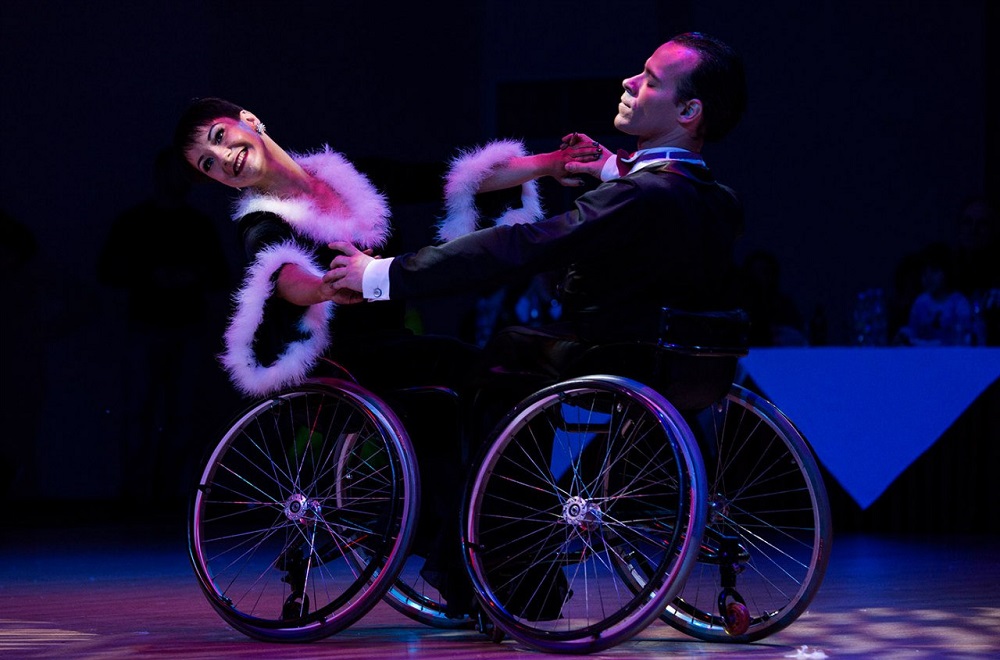 I am sure that the latest data: the Court of Arbitration for Sport (CAS) has ruled on the dispute between the World Anti-Doping Agency (WADA) and the Russian Anti-Doping Agency (RUSADA). By a court decision, athletes from Russia will not be able to compete under the flag of the country until December 16, 2022.) "> At the next championship, we will surprise everyone!
I am sure that the latest data: the Court of Arbitration for Sport (CAS) has ruled on the dispute between the World Anti-Doping Agency (WADA) and the Russian Anti-Doping Agency (RUSADA). By a court decision, athletes from Russia will not be able to compete under the flag of the country until December 16, 2022.) "> At the next championship, we will surprise everyone!
Source
(Estonia, Narva) Venue: VI International Charity Dance Festival “Inclusive Dance”, a gala concert of which took place in Moscow on November 1, 2018. The festival is aimed at the development of inclusive dance art, and is the largest in the world in this area.0004
Recommended for viewing:
Introduction to Dance Studio Inspiration
Narva dancers from "Happy Hearts" took part in the international festival
The inclusive dance group "Happy Hearts" took part in online dance show
Kind of sport - wheelchair dancing, charity fund
Contacts:
Wheelchair Dance Sports Club “Dance on Wheels” for people with PHDTrainings are held at:
St.
 Petersburg, Embankment r. Moiki, 23.
Petersburg, Embankment r. Moiki, 23. Head coach of the St. Petersburg wheelchair dance team for persons with POD
Lozko Elena Petrovna
tel. 8 (911) 911-55-46
Registration for classes is carried out on the club website:
www.wdr.ru and by phone: 234 54 32, 234 18 56
Our athletes:
OOI SK "Dance on Wheels"
Wheelchair dancing is practiced in different forms:
- this is also a single dance (SINGLE DANCE) - when one person is dancing, sitting in a wheelchair;
- duet dance (DUO DANCE) - two partners in wheelchairs dance;
- combined dance (COMBI DANCE) - when a person in a wheelchair is paired with a non-disabled dancer;
- dance in an ensemble (GROUP DANCE) - several partners in wheelchairs or together with partners not in wheelchairs.
There are many different styles of such dances: modern dance and ballet, folk and ballroom, European and Latin American.
History
Wheelchair dancing was most developed in the Netherlands. At the initiative of one of the founders of this type of dance, Corey Van Hougten, a small town of Boxmere, has been hosting a grandiose dance performance "World Cup" every spring for many years, which attracts about a thousand dancers. For two days from morning to late evening, both beginners and winners of various international competitions compete in various forms of dance here.
The first official international competition took place in 1997 in Sweden. The first World Championship was organized in Japan in 1998.
In 1998, wheelchair dancing as a sport was included in the list of the International Paralympic Games.
In October 1999, Greece (Athens) hosted the European Dance Championship, which was attended by 29 dance couples from Belarus, Belgium, Finland, Germany, Greece, the Netherlands, Norway, Poland and Russia. They performed in two programs "Standard Dances" and "Latin American Dances" in two classes. These performances were rated as the performances that took place at the highest level in any regional and world championships in wheelchair dancing.
They performed in two programs "Standard Dances" and "Latin American Dances" in two classes. These performances were rated as the performances that took place at the highest level in any regional and world championships in wheelchair dancing.
For the first time, wheelchair dancing was included in the program of the Paralympic Games in 2000. The first official World Championship was held in Oslo, Norway.
Rules
Wheelchair Sport Dances included in the Paralympic Games are COMBI DANCE dances. They are held under two programs:
- classical European dances (Slow Waltz, Tango, Viennese Waltz, Slow Foxtrot and Quickstep)
- Latin American dances (Samba, Cha-cha-cha, Rumba, Paso Doble and Jive).
DUO DANCE - so far only included in competitions held by individual countries.
COMBI DANCE - a wheelchair dancer dances with a standing partner.
Dance couples - partners must be female and male, one of whom uses a wheelchair. They are divided into 2 classes (1 and 2) according to the degree of disability of the wheelchair dancer.
Judicial evaluation criteria in Combi Dance are:
1. Beat and Rhythm
2. Technique and specificity
3. Harmony and expressiveness
4. Choreography
History of development in Russia
In Russia, wheelchair dancing originated in St. Petersburg in early 1997. A year later, following the example of enthusiasts from the northern capital, an interesting dance ensemble appeared in Veliky Novgorod: young people in wheelchairs and deaf girls began to demonstrate their abilities and rapidly growing skills in the arenas of the city. More recently, wheelchair dancing came to Novosibirsk and Perm.
Meanwhile, the Russian pioneers, Petersburgers, having registered the Dance on Wheels club at the end of 1997, eagerly absorbed the best European and world dance experience in both sports and modern dances. Performing with dance-concert numbers, they did not miss the opportunity to enter the international arena, where they gained respect and authority in two or three years.